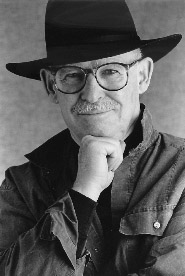
ABOUT MY ART
It is important at the outset to make clear that I am 87 years old. I have been painting for 50 years. My Sonoma studio is full of paintings that are similar in style to the ones shown here on my website.
Many events of my life have a bearing on why I paint what I do. The first event was that I was born in one of the most beautiful places on earth: The Hood River Valley in northern Oregon. It is nestled in a break in the Cascade Mountains. At the north end of the valley is the beautiful Columbia River. The valley itself is completely filled with fruit orchards that blossom in the spring. At the south end sits the star of this "Garden of Eden"; dramatic snow capped Mount Hood. The first twenty one years of my life I spent in my father's apple and pear orchard absorbing that beauty.
World War ll took me away to service in the U.S. Navy. When the war ended I was discharged in San Francisco and I decided to stay. A few years later I graduated from San Francisco State College with a Masters degree in Art Education. My training program contained many elements: figure drawing, perspective, print making, etc.
One of the biggest components was spent sitting in a darkened room for hundreds of hours watching an enormous slide collection covering the entire history of both western and asian art. It was an extremely rich diet. When I graduated I started teaching and continued doing that for the next thirty years at many levels. I retired in 1983.
In 1959, while still a teacher, I started painting. This meant that I had to find my personal position with respect to all those great masters of the past, an enormously daunting library. What was I going to do with Cezanne, Picasso, and all the hot new American stars? Then it dawned on me that Picasso had in effect ignored all the past greats and simply did what only he could do. Aha!
I could do the same—respect, yes and ignore. Pay homage yes, by doing what Cezanne had said "add a link to the chain". After feeling a deep regard of the past I came to feel that it was empowering me to try to add my own "link to the chain".
When I started making the actual paintings, I began to see that I was drawn to simple, quiet spaces—big open spaces. The kind of space in which one could experience awe and serenity. By this time in my life I had seen a great deal of that part of America that lies west of the Mississippi River. My western landscape was full of vast, heroic spaces that produce heart-stopping wonder.
It is no accident that an artist who grew up in the "Garden of Eden" that was known as the Hood River Valley in Oregon, would fall in love with the dramatic grandeur of the American West.
It is my hope that somehow a major retrospective exhibition of my work can be arranged so that everyone can experience what I call my Poems of Praise.
Critical Reviews
In 1965 Alfred Frankenstein of the San Francisco Chronicle wrote:
"The smooth and calculated element comes from the brush of Dale Diamond, who combines hard-edge painting with landscape in a most effective style. At first glance, most of his canvases seem totally abstract; then a whole series of spatial references becomes apparent, like the figures in a photographic print undergoing development; in this sense the paintings are curiously dynamic. Diamond's design is very crisp, his surfaces and colors as neatly barbered as they come, and he has a nice way of nudging an extra fillip of meaning into things with a title. A title like 'Parking Place for Mondrian on Bastille Day' may seem outlandish but it really isn't. You'll have to visit the Art Center to find out why."
In 1966 John Canady of the New York Times wrote:
"Mr. Diamond's big, bright, hard-edge (razor-edge, in truth) abstractions reduce landscape ("Low Tide," "Golden Gate") to three or four ultimately simplified areas of flat color. Anybody can do it. But Mr. Diamond does it with disciplined brilliance. "Flat"—to go back a sentence—is not really a good word for his color. Although the areas are ungraded, they are established in vibrant, or deliberately quiescent, juxtapositions to one another without making their optical relationships an independent goal. An essence of landscape is always held within these paintings where no landscape forms are recognizable, Mr. Diamond is very good at a difficult job that looks easy."
In 1971 Thomas Albright of the San Francisco Chronicle wrote:
"The painter at Bolles is an artist named Dale Diamond, who does minimal—and at his best, mystical—landscapes. Diamond sometimes divides his canvases with undulating horizon lines that separate broad areas of strongly contrasting color; in "Marin," wavy knolls of color are arranged in vertical strata and appear to recede into their white surroundings.
Diamond's most effective paintings, are those that restrict themselves to subtle tonal variations—white on white, blue on blue—and employ an extremely spare vocabulary of nuance and geometric shapes to suggest vast dimensions of space and symbol."
Some Words — by Dale Diamond
The way is toward greater and greater simplicity.
"Learning is adding day by day, but the practice of Tao consists in
subtracting day by day, and yet again subtracting." Tao te Ching, #48.
This is going in the opposite direction from decoration,
from mannerism, from cleverness without spirit or meaning.
Truth is simple.
Truth comes from the soul and speaks to the soul.
Whence comes cleverness and to what does it speak?
Cleverness tries to become.
Simplicity is.
"The Tao of the sage is work without effort." Tao te Ching, #81.